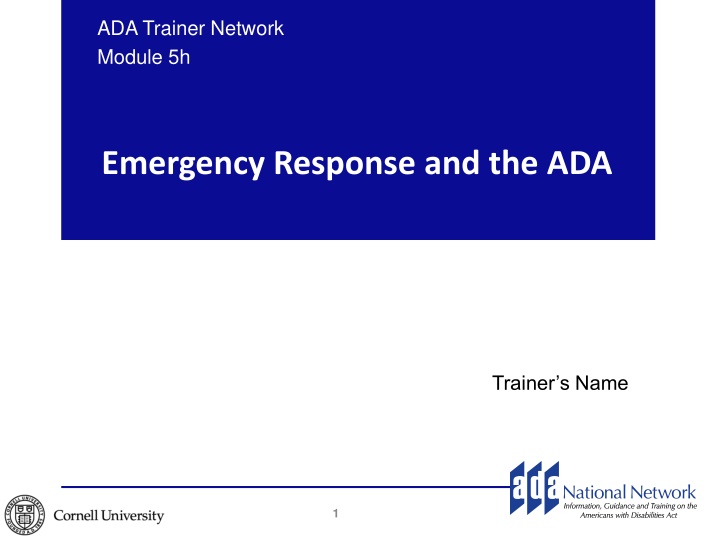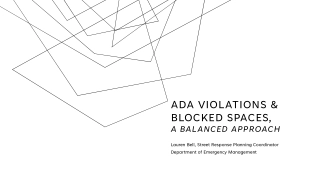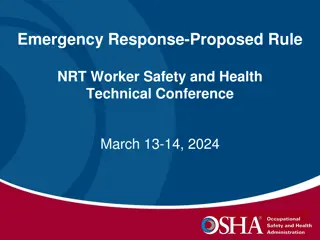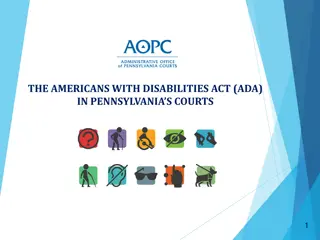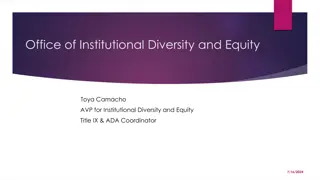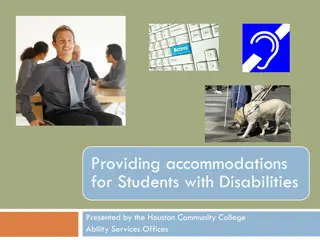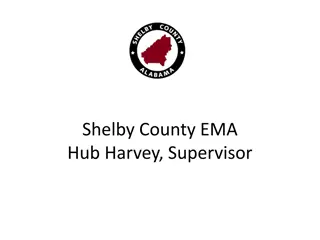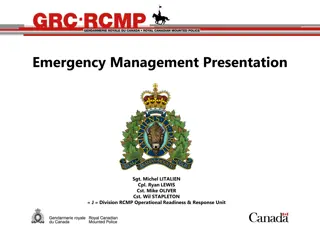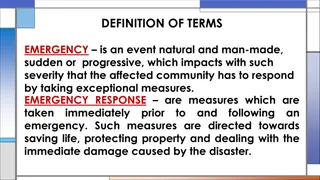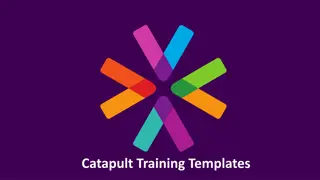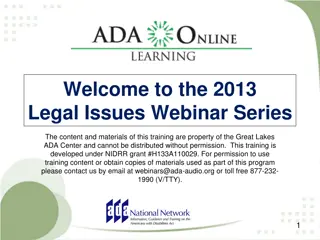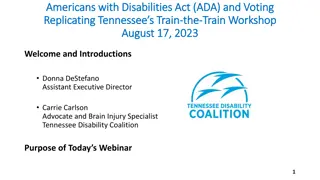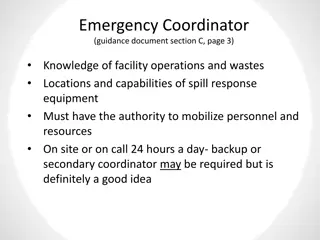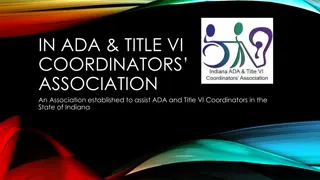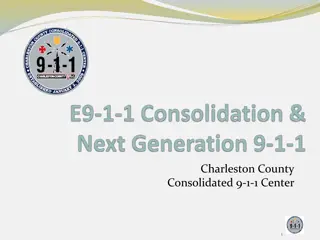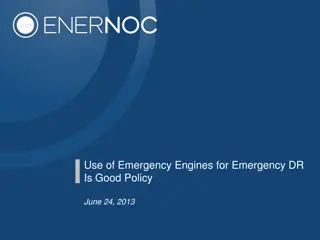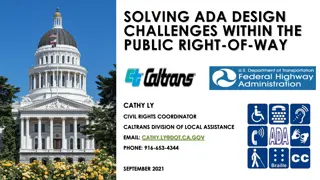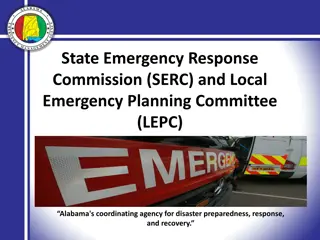Emergency Response and the ADA
In-depth guidance on emergency response procedures and effective communication strategies to ensure ADA compliance. Explore topics such as accessible shelter locations, transportation considerations, and factors for effective communication. Learn about examples of accommodations for hearing, speech, and visual disabilities. Stay informed and prepared to meet the needs of individuals with disabilities during emergencies.
Download Presentation

Please find below an Image/Link to download the presentation.
The content on the website is provided AS IS for your information and personal use only. It may not be sold, licensed, or shared on other websites without obtaining consent from the author.If you encounter any issues during the download, it is possible that the publisher has removed the file from their server.
You are allowed to download the files provided on this website for personal or commercial use, subject to the condition that they are used lawfully. All files are the property of their respective owners.
The content on the website is provided AS IS for your information and personal use only. It may not be sold, licensed, or shared on other websites without obtaining consent from the author.
E N D
Presentation Transcript
ADA Trainer Network Module 5h Emergency Response and the ADA Trainer s Name 1
Disclaimer Information, materials, and/or technical assistance are intended solely as informal guidance, and are neither a determination of your legal rights or responsibilities under the ADA, nor binding on any agency with enforcement responsibility under the ADA. The Northeast ADA Center is authorized by the National Institute on Disability, Independent Living, and Rehabilitation Research (NIDILRR) to provide information, materials, and technical assistance to individuals and entities that are covered by the ADA. The contents of this presentation were developed under a grant from NIDILRR, grant number 90DP0071-01-00. NIDILRR is a Center within the Administration for Community Living (ACL), Department of Health and Human Services (HHS). The contents of this presentation do not necessarily represent the policy of NIDILRR, ACL, HHS, and you should not assume endorsement by the Federal Government. 2
The ADA Applies to: All services, programs, and activities of state and local governments including those offered through a third party. The goods, services, and facilities of private businesses. 3
ADA, Program Access, and Emergency Planning Identify physically accessible shelter locations Consider the needs of those with mobility, psychiatric, sensory, and cognitive disabilities Ensure access to reliable, accessible transportation Prepare Knowledgeable, welcoming, staff and volunteers 4
Effective Communication Is communication that is as effective as that provided to people without disabilities Covers warnings, announcements, intake procedures, and interpersonal communication 5
Factors to Consider Duration and complexity of the communication Context of communication Number of people involved and/or in need of the communication Importance and potential impact of the communication 6
Examples of Effective Communication Hearing disabilities - Qualified interpreters, captioning of emergency alerts, transcription services, video remote interpreting (VRI) Speech disabilities - Speech synthesizer, computer/tablet, communication board Visual disabilities - alternate format such as large print or braille, screen reader accessible web and mobile applications, readers, assistance with directions in unfamiliar surroundings 7
Structural Accessibility All new construction and alterations to existing facilities must be readily accessible to and usable by people with disabilities Do not have to make an existing facility accessible if able to provide program access If program access not possible, then must provide structural access unless it would result in undue burden or fundamental alteration 8
Service Animals A dog or in some cases, a miniature horse) Used by people with a variety of disabilities May or may not be harnessed/identifiable Must be allowed to enter the shelter even if there is a No Pets policy Can ask Is this a service animal? and What task has the animal been trained to perform? Cannot impose additional fees, surcharges, deposits, etc. for having/allowing a service animal 9
Reasonable Modification Must make reasonable modifications to policies, practices and procedures, when needed to avoid discrimination. 10
Planning for People with Disabilities Access to information; notifications, communications, warnings Evacuation including transportation Physical access to shelters Availability of medications, refrigeration, and back-up power sources Plan of an individual to use their mobility device in an emergency environment Need to keep service animal with the person 11
Planning for Disability Specific Needs Mobility disabilities Accessing shelter quickly in an emergency event Loss or damage of durable equipment or mobility aids Returning home over a debris covered path of travel Repairing a damaged home 12
Planning for Disability Specific Needs Sensory disabilities Reading materials in an inaccessible format Hearing warning alerts or seeing danger areas on a weather map Understanding what a meteorologist is saying if no captioning is provided Dealing with navigational obstacles in temporary housing or shelter 13
Planning for Disability Specific Needs Cognitive disabilities Fear of unfamiliar people including first responders Difficulty comprehending instructions, particularly from multiple sources Isolation in shelter if separated from family member, friend, or companion Having an official assume that she or he does not understand 14
The Emergency Planning Process Include people with disabilities in planning Consider preparation, notification, response, clean up, and return Employ a collaboration of community supports 15
Additional Resources Guide for Local Governments http://www.ada.gov/emergencyprepguide.htm Best Practices Tool Kit http://www.ada.gov/pcatoolkit/chap7emergenc ymgmt.htm Planning for Employees with Disabilities http://www.dol.gov/odep/pubs/fact/effective.ht m 16
Additional Resources Northeast ADA Center s Business Community Brief http://www.northeastada.org/docs/DBTAC_Research%20Brief_B usiness%20Continuity%202.pdf Free Emergency Preparedness Webinars http://adapacific.org/emergency/webinars.php Produced by the Pacific ADA Center and the ADA National Network 17
Northeast ADA Center K. Lisa Yang and Hock E. Tan Institute on Employment and Disability Cornell University Dolgen Hall Room 201 Ithaca, New York 14853-3901 Toll-Free : 800.949.4232 (NY, NJ, PR, USVI) Telephone 607.255.6686 Fax 607.255.2763 TTY 607.255.6686 Email northeastada@cornell.edu Web www.northeastada.org The contents of this presentation were developed under a grant from the National Institute on Disability, Independent Living, and Rehabilitation Research (NIDILRR grant number 90DP0071-01-00). NIDILRR is a Center within the Administration for Community Living (ACL), Department of Health and Human Services (HHS). The contents of this presentation do not necessarily represent the policy of NIDILRR, ACL, HHS, and you should not assume endorsement by the Federal Government. 18
